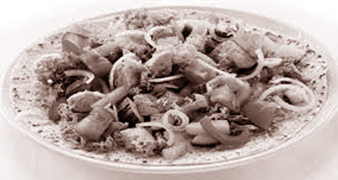Health Byte
Calling cancer
A new study published in the journal Pathophysiology, shows (yet
again) the potential links between long-term cell phone use and
malignant brain cancer. The study, conducted in Sweden, demonstrates
that people who used cell phones for more than 25 years had a 3 fold
increase in malignant brain cancer, compared to people who had used cell
phones for less than 1 year.
Another recent study suggests human saliva may serve as a red flag
proving cell phones can cause harm. This study arose from concerns that
the very low levels of radiation emitted by cell phones may damage
tissues of the head and neck, since cell phones are typically held close
to the ear for long periods of time. Researchers in Israel studied the
saliva of 20 people who had been using mobile phones from eight to 15
years with an average time on the phone of 29.6 hours per month. The
researchers focused on changes in saliva associated with oxidative
damage to human cells. (Oxidative damage can occur when unstable
molecules such as free radicals wreak havoc on cells, tissues and DNA.)
The results of this study showed that mobile phone users had a
significantly higher increase in salivary markers for oxidative damage,
compared with a group of deaf people.
Dialing up DNA damage
All of this research adds to a growing body of evidence that mobile
phone use is capable of damaging human cells. Studies published in other
prestigious journals that look into oral medicine and oral diseases have
found that mobile phones can directly damage cells in the salivary
glands, causing the glands to become over stimulated.
 Other
recent reports provide insight into what may actually be happening to
human cells affected by mobile phone radiation. Recent research found
that cell phone radiation may cause DNA damage and alter genes in brain
cells. Additionally, a study of male volunteers tells us that long-term
use of mobile phones can cause DNA damage and chromosomal instability in
cells of the oral cavity and lymphatic system that could increase the
risk of cancer. Other
recent reports provide insight into what may actually be happening to
human cells affected by mobile phone radiation. Recent research found
that cell phone radiation may cause DNA damage and alter genes in brain
cells. Additionally, a study of male volunteers tells us that long-term
use of mobile phones can cause DNA damage and chromosomal instability in
cells of the oral cavity and lymphatic system that could increase the
risk of cancer.
Still, the debate over potentially harmful effects of long-term cell
phone use is likely to rage on for years. The mobile phone industry and
its lobbying groups provide plenty of funding for studies that find no
link to ill health effects or are at least inconclusive. Health
activists who carry the findings of studies like these too far also
provide fuel for the critics. But while the public waits for definitive
answers, we can take protective measures with an antioxidant rich diet
and extra supplementation to prevent or reduce possible risks linked to
cell phones. The same measures may reduce health risks associated with
many other forms of oxidative damage.
*******
The 411 to prevent a 119
Strategies such as antioxidant protection, improved circulation,
hydration and detoxification of heavy metals can be very useful.
Vitamins C, A, E and D3, as well as lipoic acid, CoQ10, selenium,
glutathione and beta-1,3 glucans are highly recommended antioxidants.
Experts also recommend reducing cell phone radiation exposure with
your speaker phone function or using a headset with an air conduction
tube leading to the ear. You can also limit the length of your
conversation or use texting. When your cell phone is not being used, it
is best to keep it away from direct contact with your body, especially
near highly sensitive organs and tissues, such as the genital area,
breasts, head and thyroid. And don’t sleep with your cell phone next to
your head.
Risk or no risk, cell phones are becoming the mainstay of personal
communications and as new uses for personal devices increase, so will
our exposure to radiation levels. No matter which side of debate a
person chooses in our high-tech society, an ounce of prevention will
always be worth a pound of cure. -Easy Health Options
Are you what you eat?
Are calories as simple as energy in, energy out? if you're trying to
drop a few pounds — or just want to maintain your weight as it is — you
may think calorie counting is all you have to do. In reality, it's a
little more complicated than that.
NBC's medical correspondent Dr. Natalie Azar busts three common
calorie myths.
 1.
You can achieve a healthy weight with the calories you eat and with the
calories you burn. 1.
You can achieve a healthy weight with the calories you eat and with the
calories you burn.
It's not only how much you eat, but what you eat. Try to balance your
daily consumption between carbohydrates (45-65 percent of daily
calories) with fat (20-35 percent) and protein (10-35 percent).
2. Excess calories are all that drive the obesity epidemic .
Wrong. For some of us, genetics, sleep patterns, activity and
hormones play a role in our weight.
3. Some foods burn more calories than they contain.
Not true!
- Today Health
Magnesium deficiency can be deadly
Know the signs:
Magnesium deficiency is one of the major contributors to cardiac
arrhythmia, angina, high cholesterol, high blood pressure and sudden
death from heart attack.
Magnesium is required by all the body’s major organs in order for
them to function properly. It regulates the body’s enzyme reactions,
transports essential ions across cell membranes and helps the body in
producing adenosine triphosphate (ATP), a coenzyme necessary for cell
metabolism.
 A
deficiency of magnesium is dangerous for the nervous system, heart and
kidneys. Unfortunately, almost everyone is low in magnesium. But there
are several telltale signs that serve to indicate low magnesium levels: A
deficiency of magnesium is dangerous for the nervous system, heart and
kidneys. Unfortunately, almost everyone is low in magnesium. But there
are several telltale signs that serve to indicate low magnesium levels:
* Muscle cramping and twitching.
* Abnormal heart contractions.
* Depression and low moods.
* Ringing in the ears.
* Kidney stones.
There is no fear of overload of magnesium in the diet. Any excess is
excreted harmlessly. Taking magnesium can bring on diarrhea in some
people the first few days, but it does not last long.
Magnesium can be used in the form of a topical salve or in an inhaler
when necessary to relieve acute bronchial spasm. Magnesium liquids
rubbed on penetrate the skin, making it possible to get much more
magnesium into children - especially small children - without the risk
of diarrhea. Vitamin B6 helps magnesium work and helps on its own to
reduce asthma. Vitamin B12 is far and away the most useful nutrient to
eliminate asthmatic wheezing, for children as well as adults up to about
age 50. However, for seniors it is best to take B12 shots, because their
intrinsic factor is usually gone and there can be little or no
absorption of B12.
- Spiritfoods
|

